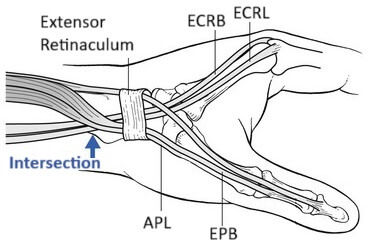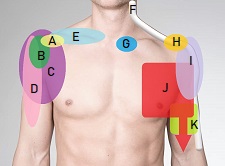- Home
- Wrist Pain Diagnosis
- Wrist Tendonitis
- Intersection Syndrome
Intersection Syndrome
Written By: Chloe Wilson BSc (Hons) Physiotherapy
Reviewed By: SPE Medical Review Board
Intersection syndrome is a type of wrist tendonitis caused by repetitive friction and overuse.
It causes pain on the back of the lower forearm, due to irritation where two groups of tendons cross-over each other or “intersect”.
Intersection syndrome typically affects people who do lots of repetitive wrist movements, or lots of gripping or lifting. It is common with sporting activities such as rowing, kayaking, racket sports and weight-lifting as well as in construction and manual labor.
The two classic features of intersection syndrome are pain and crepitus on the back of the forearm, just above the wrist, that get worse with wrist or thumb movements.

In most cases, intersection syndrome will settle down with rest, physical therapy, splinting and exercises, but occasionally injections or surgery may be recommended.
Here we will look at what is intersection syndrome, the common causes and symptoms and the best treatment and prevention options.
What Is Intersection Syndrome?
Intersection syndrome is an inflammatory condition that occurs when there is excessive friction between two groups of tendons on the back of the forearm. These tendons are responsible for movements such as extending your wrist and thumb.
Approximately 4-6 cm above the back of the wrist joint, the tendons of abductor pollicis longus (APL) and extensor pollicis brevis (EPB) cross over, or “intersect”, with the tendons of extensor carpi radialis longus (ECRL) and brevis (ECRB).
Repetitive friction between the tendons at this junction causes pain and inflammation, resulting in Intersection Syndrome. Inflammation develops in the tendon sheath, a layer of connective tissue which surrounds and protect the tendons and helps them to move smoothly, leading to tenosynovitis.
Intersection syndrome is also known as Oarsman’s Wrist, Crossover Syndrome, Squeaker’s Wrist, Peritendinitis Crepitans and APL Syndrome.
Causes Of Intersection Syndrome
Intersection syndrome is typically caused by repetitive wrist movements, especially those involving frequent extension and flexion of the wrist and thumb. While anyone can develop intersection syndrome, certain activities and professions make some people more susceptible.
Common causes of Intersection Syndrome include:
- Repetitive Strain: Overuse is the most common cause of intersection syndrome pain. Activities like rowing, weightlifting, skiing, or even extensive typing can stress the wrist tendons, causing them to rub against each other and become inflamed. For example, rowers consistently engage their wrist extensors and flexors as they pull the oars, hence the condition often being referred to as Oarsman’s Wrist.
- Occupational Activities: Jobs that require repetitive wrist and hand movements or gripping and twisting activities, such as assembly line work, construction or carpentry, can irritate the tendons over time, leading to intersection syndrome wrist pain.
- Sports: Certain sports, particularly those involving gripping or repetitive wrist movements like tennis, kayaking, and cycling, are common culprits, particularly if athletes don’t use proper technique or take appropriate rest periods.
- Acute Trauma: Less commonly, intersection syndrome can develop after a direct injury to the wrist area, such as falling onto an outstretched hand. Acute trauma can result in an inflammatory response that mimics the symptoms of chronic overuse, resulting in intersection syndrome.
Intersection Syndrome Symptoms
The most common symptoms of intersection syndrome include:
- Wrist & Forearm Pain: Intersection syndrome pain is typically located on the back of the forearm, about 4-6 cm above the wrist, where the tendons intersect. People often describe it as a dull aching pain with occasional sharp, stabbing sensations. Intersection syndrome pain usually worsens with activity, especially movements that involve wrist extension or thumb movements. Initially intersection pain may be mild and only present during activities that use the wrist and thumb extensors, but as the condition worsens, the pain may become more constant and even occur at rest.
- Swelling: Inflammation in the tendons can cause visible swelling in the affected area. The skin over the intersection point may appear puffy, and the swelling can extend along the forearm as the condition progresses. Intersection syndrome swelling is often accompanied by tenderness when the area is pressed.
- Crepitus: A tell-tale intersection syndrome symptom is crepitus, which is a crackling or grating sound that can be felt or heard when moving the wrist. This is caused by the friction between the inflamed tendons. It is one of the most defining features of intersection syndrome.
- Restricted Movement: As the inflammation worsens, wrist and thumb movement may become restricted. You may notice stiffness in the wrist, making it difficult to perform everyday tasks like gripping objects, typing, or turning doorknobs. The pain and swelling may also make it harder to extend your wrist fully.
Intersection syndrome symptoms usually come on gradually but can sometimes appear after a single bout of intense activity.
Diagnosing Intersection Syndrome
A healthcare professional can usually diagnose intersection syndrome based on a physical examination and a review of your symptoms.
The location of the pain, swelling, and crepitus are key diagnostic indicators. However, in some cases, additional tests might be needed to rule out other conditions like Carpal Tunnel Syndrome, TFCC Tear, De Quervain’s tenosynovitis, Wrist Fracture, Scaphoid Fracture or other types of wrist tendonitis.
Diagnostic tests for intersection syndrome may include:
- Ultrasound: is often the preferred imaging modality because it can show inflammation in the tendons and detect any fluid accumulation around the tendons, indicating inflammation
- MRI: can provide more detailed images and may be used to visualize the tendons and surrounding tissue more clearly

#CommissionsEarned from Amazon on qualifying purchases
Intersection Syndrome Treatment
Intersection syndrome can usually be treated with conservative methods, meaning surgery is rarely needed. Common intersection syndrome treatment options include:
1. Rest
The first and most crucial step in intersection syndrome treatment is to stop the activity that’s causing the inflammation. Resting the wrist and forearm allows the tendons time to heal and reduces further irritation.
If rest is not an option due to work or other obligations, modifying the way you perform certain tasks can help. For example, changing your wrist position while typing or adjusting your grip when lifting objects can reduce strain on the tendons.
2. Ice Therapy
Applying an ice pack to the affected area for 15-20 minutes several times a day can help reduce inflammation. The cold constricts blood vessels, reducing the flow of inflammatory fluids into the tissues, while also numbing the area to provide temporary pain relief.
Be sure to wrap the ice in a cloth, or use a specially designed ice bag to avoid skin damage.
3. Anti-inflammatory Medications
Over-the-counter nonsteroidal anti-inflammatory drugs (NSAIDs) like ibuprofen/Advil can help reduce both pain and inflammation. In some cases, your doctor may prescribe a stronger medication if necessary.
4. Splinting

Wearing a splint or intersection syndrome brace to immobilize the wrist and support the thumb can help prevent further irritation of the tendons.
Wrist splints are especially helpful during the early stages of treatment or when resting isn’t enough to relieve symptoms, and can be helpful when returning to sports.
5. Physical Therapy
A physical therapist can design a specific intersection syndrome exercise program to strengthen the muscles around the wrist, improve flexibility, and prevent recurrence.
Electrotherapy such as ultrasound or shockwave therapy may also be used to promote circulation and reduce inflammation which can help to speed up the healing process.
In some cases, manual therapy techniques such as soft tissue mobilization or massage may be used to reduce stiffness and promote healing in the tendons.
6. Intersection Syndrome Exercises
Exercises are a really important part of intersection syndrome treatment and prevention and typically include:
- Stretching Exercises: Gently stretching the wrist extensors and flexors can help improve flexibility and reduce tendon tightness. Stretching intersection syndrome exercises should be done slowly and carefully to avoid further irritation.
- Strengthening Exercises: Once the inflammation subsides, strengthening the muscles in the wrist, forearm, and hand is important to prevent future episodes of intersection syndrome. Strengthening intersection syndrome exercises may include wrist extensions, wrist curls, and thumb lifts with light weights or resistance bands.

7. Corticosteroid Injections
In more severe or persistent cases, a corticosteroid injection may be used to reduce inflammation in the tendons and provide pain relief. This treatment is typically considered when other conservative methods haven’t worked.
There are potential risks with corticosteroid injections, including weakening of the tendon tissue, so they are usually not the first line of treatment for intersection syndrome and are used sparingly.
8. Platelet-Rich Plasma (PRP) Therapy
PRP therapy is an emerging treatment for intersection syndrome that uses your own blood to promote healing. A sample of your blood is drawn and then processed to concentrate the platelets. The platelet rich plasma is then injected into the affected tendons, where it promotes healing by stimulating cell growth and repair.
9. Intersection Syndrome Surgery
Surgery is usually a last resort and is rarely needed for intersection syndrome treatment. However, in chronic or severe cases, a surgical procedure may be performed to release the pressure on the tendons and remove any thickened or inflamed tissue. This helps to reduce friction at the intersection point.
Recovery from intersection syndrome surgery typically involves a rehabilitation program with physical therapy.
How To Prevent Intersection Syndrome
Prevention is always better than cure. Once intersection syndrome has been treated, taking steps to prevent it from recurring is essential, especially if the activities or sports that caused it are part of your daily life. The best ways to prevent intersection syndrome are:
- Ergonomic Adjustments: If your job involves repetitive wrist movements, adjusting your work setup to minimize strain can help. For example, using ergonomic keyboards, wrist supports, and adjusting the height of your workstation can reduce pressure on the tendons.
- Proper Technique in Sports: For athletes, using proper form and technique when engaging in activities like rowing, weightlifting, or skiing is crucial to prevent intersection syndrome. Proper warm-up and cool-down routines, as well as stretching, are also key.
- Take Breaks: If you’re involved in repetitive activities, be sure to take regular breaks to allow your tendons to rest. Avoid overloading the tendons with prolonged, intense activity without giving them adequate time to recover.
Frequently Asked Questions
Here you will find answers to the most frequently asked questions about Intersection Syndrome.
What Is Intersection Syndrome?
What Is Intersection Syndrome?
Intersection syndrome is a painful condition caused by inflammation and irritation of the tendons in the forearm, typically due to repetitive wrist and thumb movements. It is an inflammatory tenosynovitis at the intersection of the 1st extensor compartment (APL, EPB) and the 2nd extensor compartment (ECRL, ECRB) of the wrist.
What Are The Classic Signs Of Intersection Syndrome?
What Are The Classic Signs Of Intersection Syndrome?
The most common symptoms of intersection syndrome are pain in the back of the forearm, approximately 4-6cm above the wrist towards the outer (thumb) side, and crepitus, a grating or creaking sensation during wrist or thumb movement
How Do You Treat Intersection Syndrome?
How Do You Treat Intersection Syndrome?
Intersection syndrome is treated with rest, ice, anti-inflammatory medications, and activity modification, often supplemented by physical therapy to strengthen and stretch the affected tendons. In more severe cases, corticosteroid injections or intersection syndrome surgery may be required.
How Long Does It Take To Recover?
How Long Does It Take To Recover?
Recovery from intersection syndrome typically takes a few weeks to a few months, depending on the severity of the condition and how well treatment and rest are followed. Most cases improve with conservative treatment within 4 to 6 weeks, but chronic or severe cases may take longer.
Intersection Syndrome Vs De Quervain's
Intersection Syndrome Vs De Quervain's
Intersection syndrome is often misdiagnosed as De Quervain’s syndrome. While they are both overuse injuries that affect the wrist and thumb, there are some key differences. Intersection syndrome causes pain 4-6 cm above the wrist on the forearm whereas De Quervain’s causes pain at the base of the thumb and wrist.
Intersection syndrome is caused by repetitive wrist and thumb flexion and extension movements whereas De Quervain’s is caused by repetitive thumb movements and gripping activities.
Crepitus just above the wrist is a classic feature of intersection syndrome causing clicking or grating sensations with wrist movements, but rarely occurs with De Quervain’s. Finkelstein’s test will be positive with De Quervain’s but not with intersection syndrome
What Are The Extensor Compartments Of The Wrist?
What Are The Extensor Compartments Of The Wrist?
There are a number of tendons that pass across the back (dorsal aspect) of the wrist. These tendons connect the forearm muscles to the hand bones and help to control wrist and hand movements.
Each tendon passes through one of six tunnels, known as the “extensor compartments”. Intersection syndrome occurs at the junction of 2 of these compartments.
The extensor compartments, from the radial (thumb) side to ulnar (pinky) side of the wrist, are made up of:
Compartment 1: Abductor pollicis longus tendon (APL) and extensor pollicis brevis tendon (EPB)
Compartment 2: extensor carpi radialis longus tendon (ECRL) and extensor carpi radialis brevis tendon (ECRB)
Compartment 3: extensor pollicis longus tendon (EPL)
Compartment 4: extensor indices tendon (EI) and extensor digitorum tendon (ED)
Compartment 5: extensor digiti minimi tendon (EDM)
Compartment 6: extensor carpi ulnaris tendon (ECU)
What Else Can Help?
Intersection syndrome is just one possible cause of wrist and forearm pain.
You may also be interested in the following articles:
- Forearm Pain
- Radial Wrist Pain
- Wrist Tendonitis
- Wrist Fractures
- Elbow Pain Diagnosis
- Wrist Pain Charts
- De Quervain Tenosynovitis
- Carpal Tunnel Syndrome
Related Articles
Medical & Scientific References
- Intersection Syndrome. National Library Of Medicine 2024
- Synthesis Of Evidence For The Treatment Of Intersection Syndrome. World Journal Of Orthopedics
- Intersection Syndrome: AN Acute Surgical Disease In Elite Rowers. BMJ Journals
- Intersection Syndrome: The Subtle Squeak Of An Overused Wrist. Journal Of The American Board Of Family Medicine
- MRI Features Of Intersection Syndrome Of The Forearm. American Journal Of Roentgenology
- Disorders Of The Thumb. Musculoskeletal Key
Page Last Updated: March 3rd, 2025
Next Review Due: March 3rd, 2027




